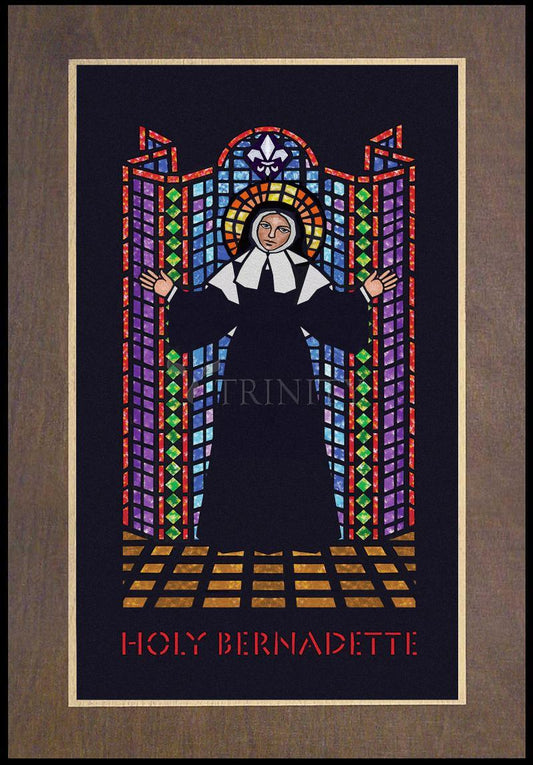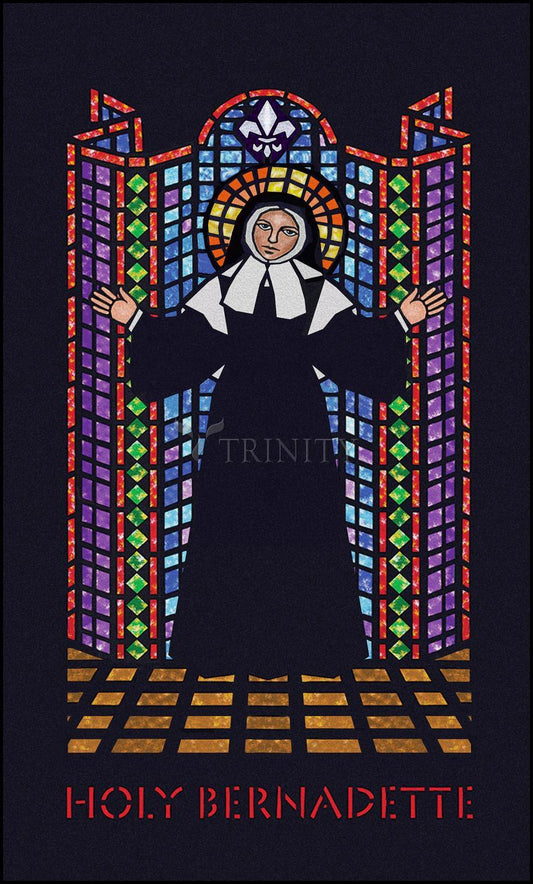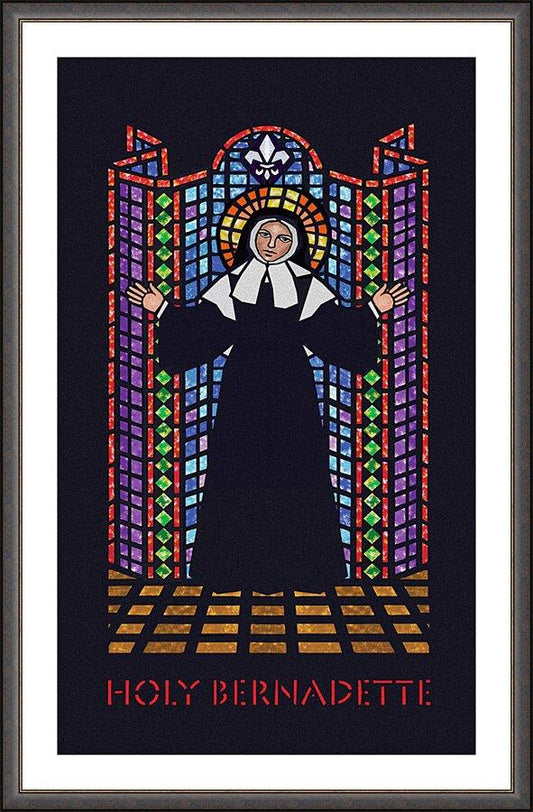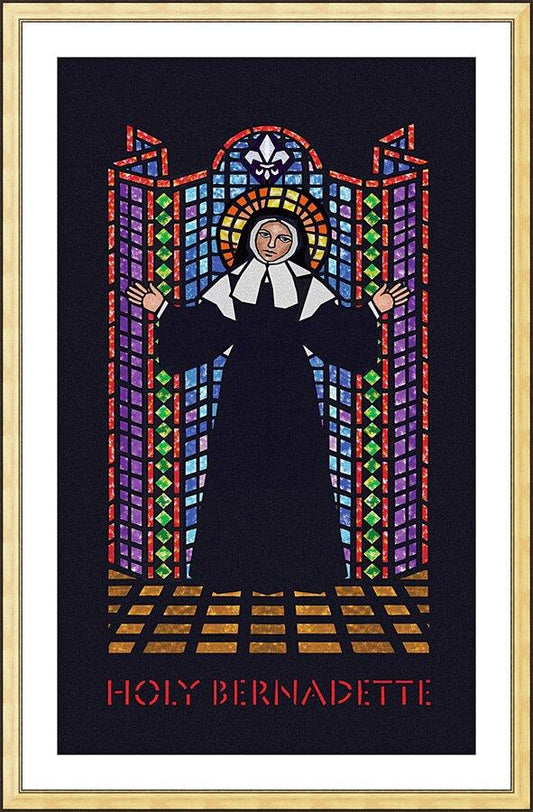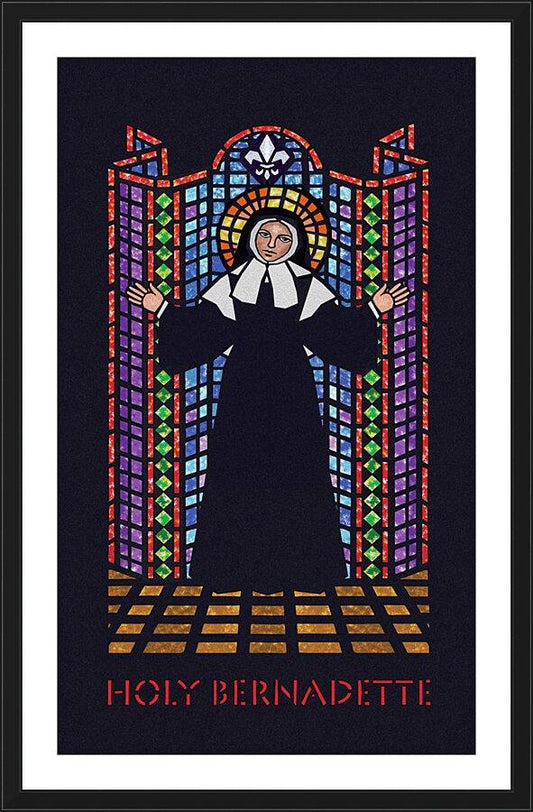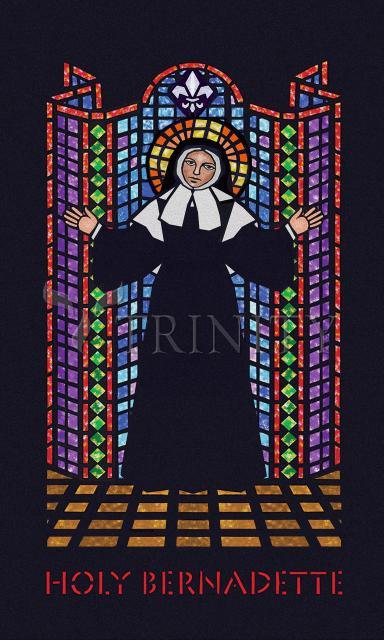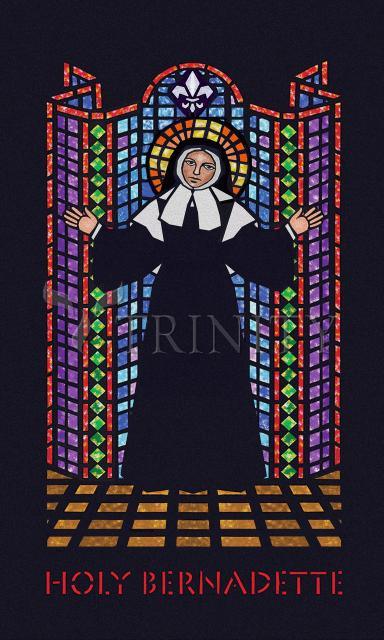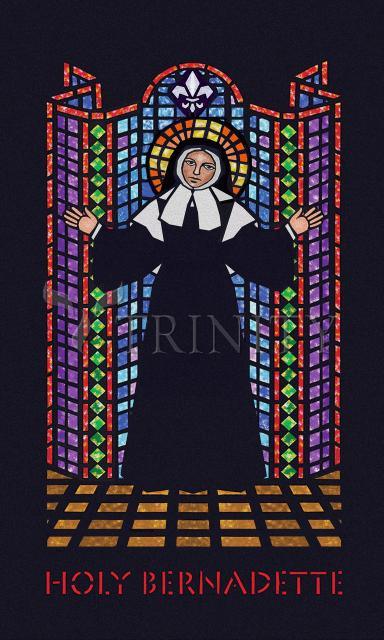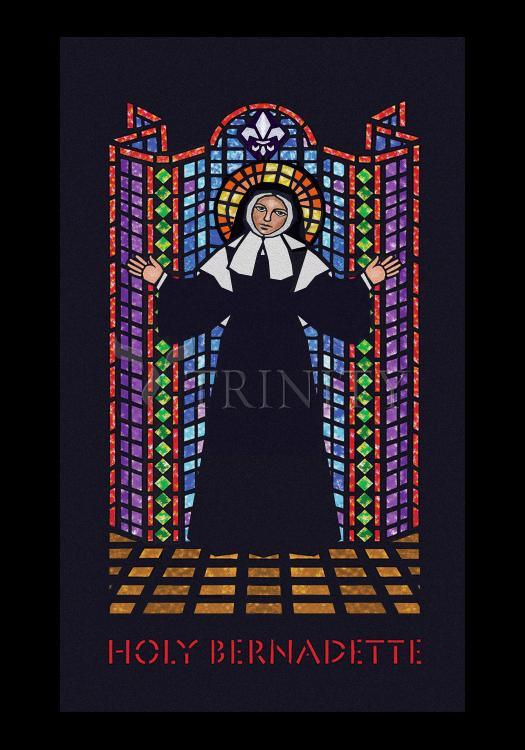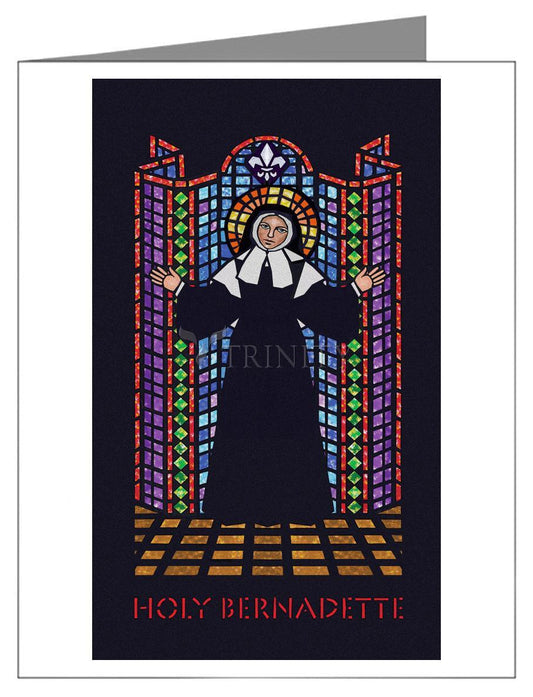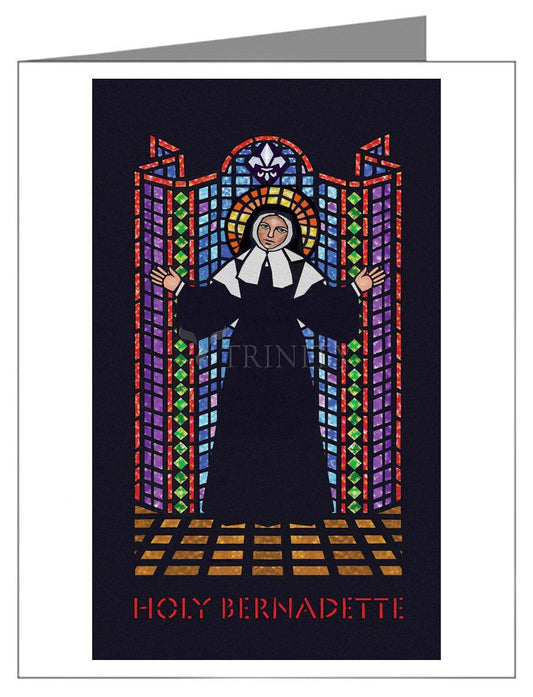Bernadette Soubirous was born in 1844, the first child of an extremely poor miller in the town of Lourdes in southern France. The family was living in the basement of a dilapidated building when on February 11, 1858, the Blessed Virgin Mary appeared to Bernadette in a cave above the banks of the Gave River near Lourdes. Bernadette, 14 years old, was known as a virtuous girl though a dull student who had not even made her first Holy Communion. In poor health, she had suffered from asthma from an early age.
There were 18 appearances in all, the final one occurring on the feast of Our Lady of Mt. Carmel, July 16. Although Bernadette's initial reports provoked skepticism, her daily visions of "the Lady" brought great crowds of the curious. The Lady, Bernadette explained, had instructed her to have a chapel built on the spot of the visions. There, the people were to come to wash in and drink of the water of the spring that had welled up from the very spot where Bernadette had been instructed to dig.
According to Bernadette, the Lady of her visions was a girl of 16 or 17 who wore a white robe with a blue sash. Yellow roses covered her feet, a large rosary was on her right arm. In the vision on March 25, she told Bernadette, "I am the Immaculate Conception." It was only when the words were explained to her that Bernadette came to realize who the Lady was.
Ann's voice was like that of an angel's, and her calm, blue eyes helped to soften the discomforting feeling one often encounters while visiting an invalid. Her remarkable beauty assisted in communicating since her gestures were unable to free themselves.
Born and raised in Jacksonville, Florida, Ann grew up with her sister, Margaret, in a household that was often in turmoil. Her parents were not happily married, nor did she ever consider her family close-knit during her childhood and teenage years.
At the age of nineteen, Ann married an Annapolis Naval Officer. At twenty-one, she gave birth to her son, Kenny, and two years later, in 1950, she was struck with polio.
It was an adjustment for everyone around her, especially for Kenny, who was two years old at the time. "It was the hardest on him. He couldn't understand why I didn't hold and caress him. But he gave my life so much meaning. He didn't know it then, but it was because of him that I forced myself to work so hard. I wanted his dreams to come true."
Life with an invalid wife was an adjustment that her husband couldn't make. Their marriage broke-up after three years of off-and-on visits to the hospital, shattering the already devastated life of this artist-rare. Ann, unable to care for herself, lost not only her physical faculties and her husband, but also her beloved five year old son. The next time the mother and child were to meet, Kenny would be fourteen!
After polio struck, Ann spent a year-and-a-half in Jacksonville, and the following year-and-a-half in a rehab center in North Carolina. The next five years of her life were spent in the strict cloister of an iron lung. There was no way or means of leaving even her bedroom because of the respiratory problem. Her parents helped in caring for her the best they could, and the National Foundation For Infantile Paralysis provided equipment and nursing services which kept her alive.
Ann was a student at a Jacksonville art school when, in 1950, the brutal disease attacked.
"They don't know how anybody gets polio. It's a virus that affects the spinal nerves. It's usually mild in children, and very severe in adults. If the nerve is weakened it can be rehabilitated. If the nerve is destroyed, then it's irreversible. In my case, the nerves were destroyed. I think that when I knew that I had polio, I was not concerned about the loss of my legs. It was losing my hands! It's just the most terrible thing in the world to have to spend your life accepting, and never being able to give back."
After years of being told that she'd never recuperate, Ann went to the Southeastern Respiration and Rehabilitation Center in Augusta, Georgia, where she was outfitted with a corset which contained a breathing device. This small miracle-machine assisted Ann in breathing for a period of four brief hours each day. As the rubber bag filled with air, Ann's chest was depressed, forcing her to exhale. When the air was released from the bag, the pressure on her chest was relieved, and she was able, then, to inhale.
"Still, the breathing is not very good. After four hours I'm moved to the bed where the rocking motion and the mouth hose makes the breathing less difficult." Twelve hours were spent in the iron lung, eight in her unique, wooden rocking bed.
Ann's four hours of daily freedom were spent in diverse ways. Her art was the most important part of her daily schedule. However, she did not limit herself to artistic creativity. Often, she delighted in going out to a movie, visiting antique shops, or simply taking a scenic drive. But art always, in the end, prevailed.
Her favorite subjects to draw were children, animals, and of course, Madonnas.
It was mysterious to Ann that she so desperately wanted to make a contribution to life; and not just to become another artist. She knew God's plan would allow her to sit-up in a wheel chair and learn how to draw again, this time, not with her hands, but with a pencil held between her teeth. It took eight long years of hospital blues before she found the courage to dive back into her career.
"My drawing is something that will always have to be done with great care. It is difficult to get the pencil to do what (in my mind) I want it to do. My designs are so small and insignificant, but the work that goes into them is not insignificant. It really does take me several months to complete the serious drawings."
Five hundred originals are still in the Adams Collection, but she sheepishly confided that the majority of the missing drawings had been stolen. "Does this shock you?" Ann asked me. "No," I responded, "Sister Mary Jean Dorcy told me that many of her original cuttings had been stolen right off the walls of her community's convents." Ann laughed sweetly, joining Sister's hopes that the thieves are enjoying their takings. Still, after the laughter died, a feeling of sadness could be heard in Ann's gentle voice: "It still breaks my heart, though, that someone would take something so precious to me."
After she completed her first Christmas design, her friends had it printed and began selling the cards locally.
"There was a man who used to come every week to pick-up my dirty sheets and take them to the laundry. His name was Sam. A gentle, sweet, humble delivery man. He loved me! He thought I was really wonderful. One week he didn't come for the sheets. Another man came. And he said that Sam was found dead in his room. He'd left an informal will and a letter. In this letter he'd asked his brother to find an outlet for my art work. I didn't realize that Sam's brother was a very prominent officer in a large chain store in the north. Sam's brother put me in touch with my present card publishers. I got my commercial start through the tender caring of this humble little man, Sam."
Over the years, millions of Ann's cards have sold. She can only give thanks to God for allowing her the dignity of earning her own way; paying for medical expenses and living independently. She knows, however, that as long as God permits her to live, she will be dependent on the loving care of others.
"Sometimes when I meet individuals that the Lord has inspired (in some way) to touch others, I can actually see them perform miracles!"
In 1956, Father John Bradshaw walked into her home, introduced himself, and out- of-the-clear-blue, asked if Ann would like to become a Catholic. "I was raised Presbyterian," she responded. After a brief silence, she remembers telling this priest that she would like to learn more about the Church, but her family would be very much against the conversion. "He told me that that really wasn't important to God, if it wasn't important to me. And that if I thought it to be right, then I had an obligation to do it. This dear friend later baptized me."
Coming to terms with total paralysis was quite an experience, and it took Ann years to deal with it. "I think the thing that gave life meaning and brought me into the Church was a book that I read --- by Fulton Sheen. It was the very first time in my life that I had ever heard that suffering has value, that suffering is redemptive. I had always thought it was something to avoid. Bishop Sheen, in his book, 'LIFT UP YOUR HEART,' explained the meaning of our sufferings united with those of Christ, and this completely changed my life. He later became one of my dearest friends, and he used to come to Jacksonville quite often to see me. He was a real, real saint! Oh, God!, do I ever miss him: unbelievably so! With all his great intellect, spiritually, he was like a little child."
But before turning her illness over to God, Ann was absolutely furious that she was unable to kill herself. She couldn't even cause her own death, and THIS was the ultimate frustration. "I learned the hard way that God has certainly given everyone something beautiful to do."
Early in her illness, Ann had many people who "made a fuss" over her. Later, when she was able to support herself, these people who cared for her when she was down-and-out, resented the fact that she could make it in the real world. "A lot of people who loved me just stopped coming. This hurt so much!" This was but one lesson that Ann had to learn about her fellow beings.
At one point in her life, Ann moved to Washington, D.C. to take part in cultural events that she wanted so desperately to attend. She learned too quickly that her presence at such places as the Kennedy Center (which was her favorite spot), was not appreciated. "They simply did not want me there. I annoyed them; and my wheel chair was an annoyance to them. They expected me to sit in the aisle behind the back seats, or in a glassed-in section of seats reserved for the press. I refused to do it."
At first, Ann was treated graciously. But when the center realized that she was going to be a permanent fixture, their attitudes changed, and subsequently - since Ann refused to be placed in the "cage," she no longer was able to frequent her gala performances she so loved. This, by no means, was her first affiliation with prejudice. Nor would it be her last.
"Always when I am in the midst of the public, I feel self-conscious. I guess I'll never be able to shake the feeling."
Ann enjoyed reading biographies, all kinds of magazines, and books about psychology. She turned the pages by pressing a button with her chin, which activated the automated book holder. Her home was richly decorated with antiques and original art, accented with oriental rugs and priceless collectibles which she, personally, selected and arranged. She also enjoyed TV, classical music, and retiring at eleven o'clock, after mastering another long, fruitful day.
Handicapped people from all across the world wrote to Ann, asking for advice and prayers. But most of her fan mail came from prisoners who just wanted to express their appreciation, respect and friendship - hoping that Ann would become their pen-pals. Although her prison walls differed from those of her fans, she felt a strong kinship with her inmate-friends.
After living nine years with his father, Ann's son returned to live with her. "It was what he wanted, and what I wanted, too."
She put Ken through high school and college, but does not hesitate to include her friends who willingly assisted them. When Ken went on to pre- med and medical school, both he and Ann met the bills; a happy collaboration which brought both of them abundant pride. Today, Ken is a hart specialist living and working in the Jacksonville area.
Ann's life could not be secure but for the devotion of Barbara Jackson and Maria McNamee. Barbara was Ann's "hands and feet" for fifteen years. "She is a rare person who understands and has to do something beautiful for God. She knows that by caring for me, in a way, she is caring for Him. There's not two people in a million who understand this. This is what makes it so hard. She's much more than even a relative to me. I know that she'll always be there."
Maria, too, was a big part of Ann's mission. She was responsible for all the secretarial chores. Without these two selfless live-ins, Ann could never had succeeded with such triumph.
At six o'clock in the morning, Ann would awaken to her alarm. "I know that I am going to have problems and frustrations during the day. I know that if I react to these things in a human way, it's going to be without any growth or merit. I try to tell the Lord everyday that I really do want to live in peace, and believe it, I don't often achieve this. I get aggravated and I get short, and I'm very opinionated; but I really, really try every day. I want Him to take care of it; I want Him to live it with me.
"Please, Dan, don't try to make me a saint. I am not! I don't want people to really think that about me. I want them to understand that God has given me a hard, hard road to walk, and I try to do it the very best I can with His grace and love. I sometimes fail. But I'm still trying. He's not through with me yet. In fact, I feel that I am just now beginning to live what God wants."
When Ann retired each night, she'd place everything in God's hands, and recite a few Hail Marys. She prayed for everyone she'd known. " ... even those I may have forgotten. We are all in His hands! I pray for them; and then I sleep --- very, very well!"
Being an artist was painful for Ann. The expectations that people placed on her were far too often unbearable. But because Ann was unaffected by her status as an artist, she always responded to those in need.
Ann passed away on May 12th, 1992. But her art work will live on in the hearts of the millions of fans who helped support her through the years. She was an angel loaned from above. Her mission was to teach all who encountered her beauty that no matter what happens - we must strive to be humble, observant, caring and creative. Thank you, Ann for loving me! And for allowing me to share your story with my friends. I miss you!
"”Ann Adams and the Art of Living - by Dan Paulos, Catholic Digest, Condensed from an Article in Our Sunday Visitor



